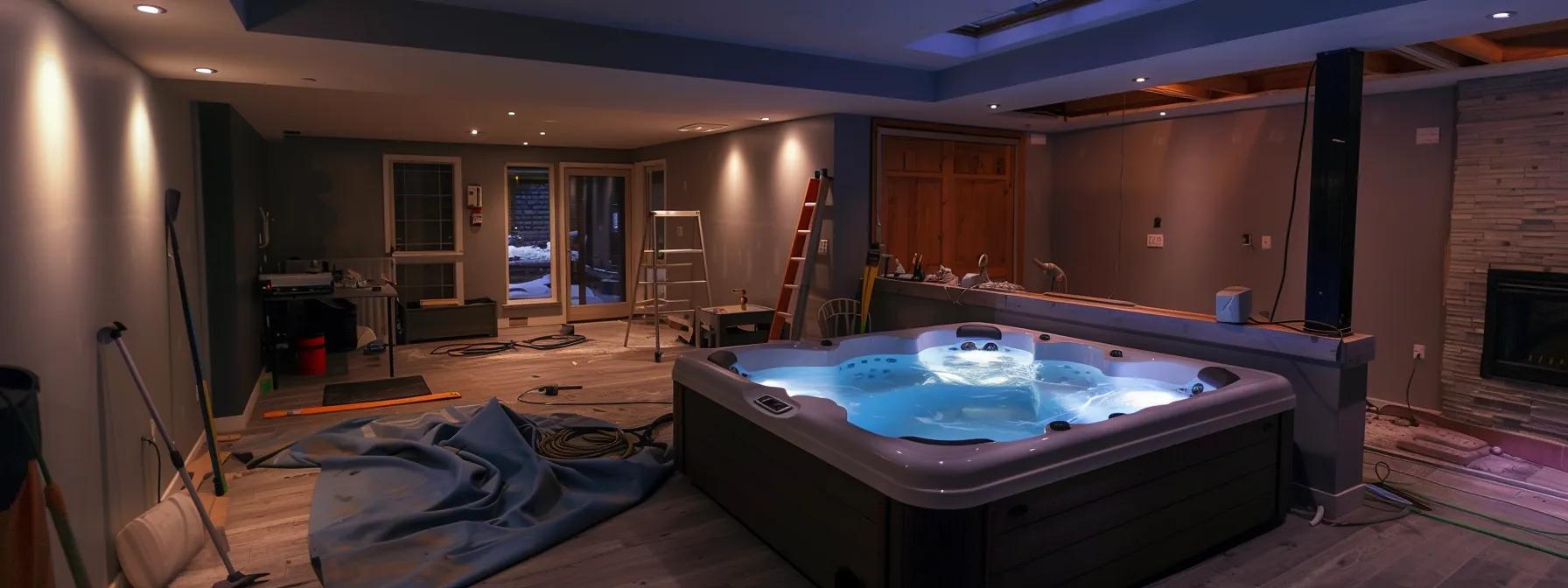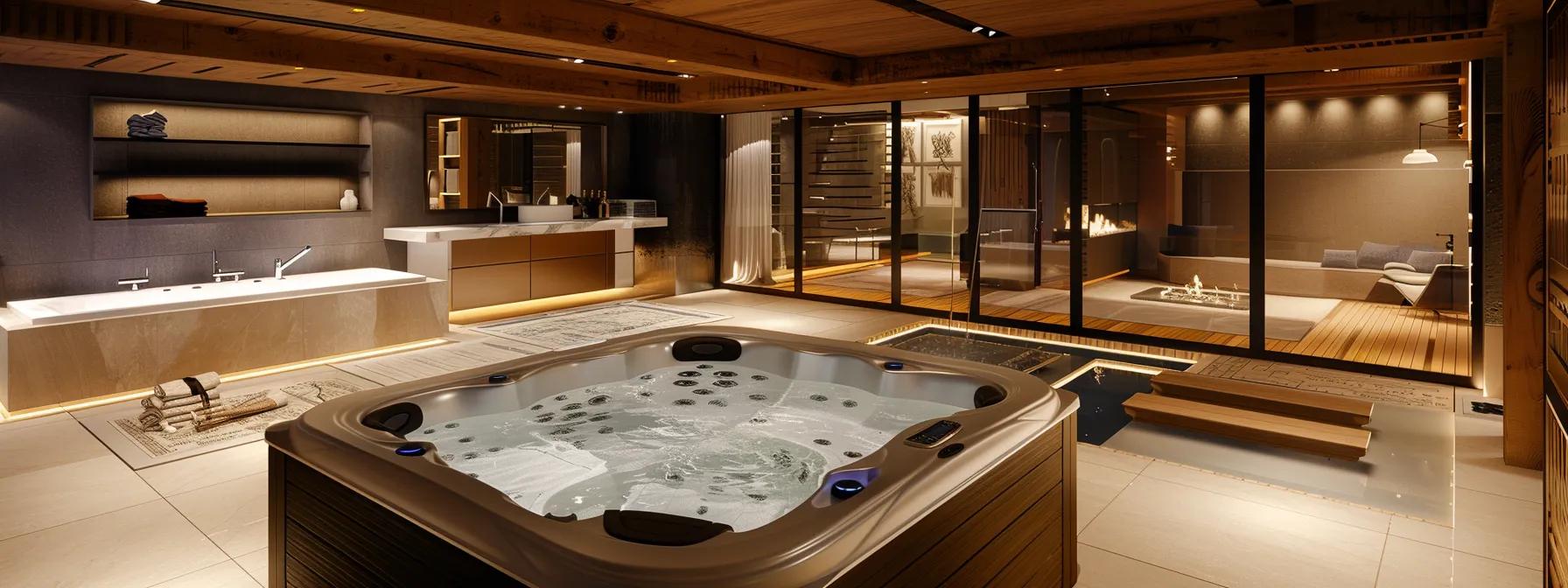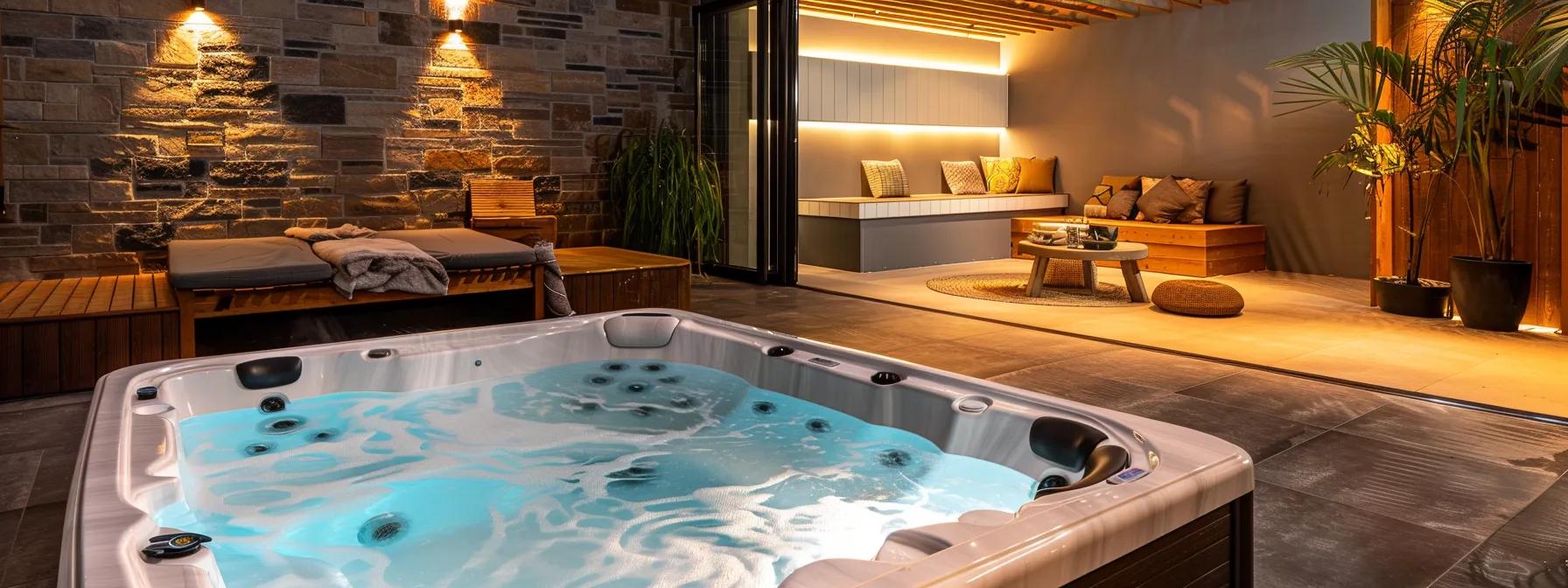Table of Contents - A Guide on How to Install a Hot Tub in Basement Spaces
- Evaluating Your Basement for a Hot Tub Installation
- Preparing the Basement Environment for Your Hot Tub
- Addressing Electrical and Plumbing Needs for a Basement Hot Tub
- The Process of Moving and Setting Up Your Hot Tub in the Basement
- Managing a Hot Tub Environment in Your Basement
- Cost Considerations for a Hot Tub Basement Installation
- Final Thoughts
- Frequently Asked Questions
This blog post may contain affiliate links. As an Amazon Associate I earn from qualifying purchases.
How to Install a Hot Tub in Basement
Installing a hot tub in your basement can transform unused space into a private retreat. Although challenges such as waterproofing, drainage (be cautious of hot tub poison ivy), electrical work, and structural support exist, proper planning and a systematic approach can create a safe, relaxing installation (watch out for hot tub rash) without compromising your home’s integrity. This guide provides clear, actionable steps to help you navigate concerns like water damage, humidity control, and code compliance while maintaining the basement’s aesthetic appeal.
Evaluating Your Basement for a Hot Tub Installation
Begin by determining whether your basement can support a hot tub both structurally and environmentally. Consider the age and materials of your basement, and review any history of water damage or mold. Since many basements are not designed for heavy installations, assessing the floor load capacity and the condition of walls is crucial.
Assessing Structural Support for a Heavy Hot TubBasement
A modern hot tub can easily exceed 4,000 pounds when filled, so ask: “Can my basement handle this weight?” Consult a structural engineer to review your concretefloor and supports. They can advise on additional reinforcements such as extra beams if needed. Also, inspect for previous water damage that may signal compromised integrity or hidden mold issues.
Measuring Available Space and Access Routes for a Hot Tub in the Basement
Once structural support is confirmed, accurately measure the basement space and access routes. Account for the hot tub’s exterior dimensions plus extra room for maneuvering and maintenance. Create a detailed floor plan to ensure that staircases, doorways, and pathways are wide enough to allow safe transportation of the heavy unit as well as access to electrical and plumbing connections.
Checking Local Building Codes and Permit Requirements for Hot Tub Basements
Before proceeding, consult local authorities about building codes and permits required for heavy equipment installations. Permits ensure modifications to electrical or plumbing systems meet safety standards. Obtaining all necessary permits early prevents legal issues and enables timely inspections to resolve any concerns.
Understanding the Challenges of a Hot TubBasement Project
Basement installations bring challenges such as high humidity, condensation, and mold. Temperature fluctuations and moisture can damage drywall and other materials. Proper insulation, ventilation, and dehumidification are essential measures to protect your home and maintain a comfortable environment in the long term.
Preparing the Basement Environment for Your Hot Tub

Preparation is key to a successful hot tub installation. By addressing environmental factors upfront, you can minimize complications related to moisture, water damage, and safety hazards.
Ensuring Adequate Ventilation to Manage Humidity in a Hot TubBasement
In a confined basement space, increased humidity can cause condensation on the ceiling and walls. Install a high-quality dehumidifier and mechanical exhaust fans to circulate fresh air. A dedicated ventilation strategy helps maintain dry surfaces, reduces the risk of mold, and extends the life of both the hot tub and the basement structure.
Implementing Waterproofing Solutions for a BasementHot Tub Area
Basements often need extra waterproofing measures to prevent seepage. Use modern waterproof membranes on walls and floors, seal joints and gaps, and consider a vapor barrier. Address any existing signs of moisture issues before installing the hot tub to significantly reduce the risk of long-term water damage.
Selecting Appropriate Non-Slip Flooring for a Safe Hot TubBasement
Safety is enhanced with non-slip flooring that minimizes accidents during spills. Options include textured tiles, specialized vinyl, or treated concrete. Choose durable materials that withstand extra moisture and occasional chemical spills from water treatments, helping to prevent injuries and costly future repairs.
Planning for WaterDrainage and Preventing Water Damage
Even with waterproofing, an efficient drainage plan is essential. Ensure floors are slightly sloped or have channels that direct excess water away from the hot tub area and the foundation. Installing a sump pump system may be beneficial during heavy discharges. Effective drainage protects against moisture accumulation and long-term water damage.
Addressing Electrical and Plumbing Needs for a BasementHot Tub
Integrating your hot tub with the home’s utilities requires addressing both electrical and plumbing needs carefully to avoid hazards such as water damage or electrical shocks.
Determining Electrical Requirements for Your Hot Tub in the Basement
Hot tubs need dedicated electrical circuits to power pumps, heaters, and lights. Calculate the total amperage required and ensure your electrical panel can support the additional load. Hiring a licensed electrician to develop a custom wiring plan—including circuit breakers and GFCI protection—is crucial for preventing power outages and reducing fire risk.
Hiring a Licensed Electrician for Safe Hot TubBasement Wiring
Due to the complexity of basement electrical systems and the moisture involved, it is safest to rely on a licensed electrician. They ensure compliance with local codes, assess risks related to water exposure, and guide you through the permit process. Their expertise minimizes the risk of accidents during installation.
Establishing a Water Source for Filling Your BasementHot Tub
Your hot tub requires a reliable water source for both initial filling and regular maintenance. Connect the unit to the nearest potable water supply and verify that the water quality meets standards to reduce issues like scale buildup or chemical imbalances. If necessary, use temporary water delivery services or professional-grade hoses to ensure efficient filling and easy maintenance.
Planning for Draining and Refilling Your Hot Tub in the Basement
Over time, water quality degrades due to chemical buildup and particulates, so periodic draining and refilling are necessary. Plan a drainage system with appropriate slopes and strategically placed channels to prevent stagnation or flooding. Automation systems can assist by controlling the draining process efficiently, allowing you to maintain optimal water quality with minimal manual effort.
The Process of Moving and Setting Up Your Hot Tub in the Basement

After ensuring the basement’s readiness and utility connections, the next step is the physical installation of the hot tub. This involves transporting the heavy unit carefully, positioning it accurately, and connecting it to electrical and plumbing systems.
Safely Transporting the Hot Tub Into Your Basement Space
Due to its weight and bulk, a hot tub must be moved using specialized equipment such as a floor crane or heavy-duty dolly. Professional movers can help avoid damage to both the tub and your home. Make sure that the access route is free from obstacles like low ceilings or narrow doorways, and use proper lifting straps and secure the unit during transport.
Positioning and Leveling the Hot Tub in Its Designated Basement Spot
Once delivered, the hot tub needs correct positioning and leveling to ensure proper operation and to avoid mechanical strain. Use leveling tools to smooth out any floor irregularities. Shims or underlayment materials can help create a stable, flat surface, reducing vibrations and stress on the basement structure.
Connecting the Hot Tub to Electrical and Plumbing Systems
With the tub in place, a licensed electrician should connect it to the dedicated circuit while ensuring that all water lines are securely attached and leak-free. Methodically check each plumbing joint and test the electrical circuits against local codes and manufacturer specifications to guarantee a safe, reliable installation.
Initial Cleaning and Filling of Your New BasementHot Tub
Before enjoying your new installation, run a thorough cleaning cycle to eliminate any dust or particles that may have gathered during installation. Gradually fill the hot tub while checking for leaks in the drainage system. Test key functions such as jet flows, heating capacity, and filtration to confirm proper operation.
Managing a Hot Tub Environment in Your Basement
Installing the hot tub is only the first step; ongoing management is essential to ensure long-term functionality and safety. Regular maintenance helps control humidity, noise, and odors, preserving a comfortable environment.
Controlling Humidity and Air Quality in Your Hot TubBasement
Managing the high humidity generated by a hot tub is critical. Excess moisture can cause condensation on ceilings and walls, leading to water damage and mold. Use high-efficiency dehumidifiers combined with exhaust fans, and consider installing humidity sensors for real-time adjustments. This proactive air quality management safeguards both the tub and surrounding area.
Addressing Potential Noise From the Hot TubPump in the Basement
Basement installations near living spaces require noise management, especially from hot tub pumps. Installing noise-dampening mats and vibration isolation mounts can reduce the noticeable hum or vibrations. Positioning the pump away from shared walls further minimizes disturbances, ensuring the tub remains a quiet, relaxing feature.
Choosing Appropriate Chemicals or Systems to Limit Odors
Proper water chemistry is essential to prevent odors from forming. Use a balanced mix of chlorine or bromine with enzymes to break down organic compounds. Additional systems like ozone generators or UV sterilizers can further reduce odors. Regular monitoring and occasional shock treatments help maintain an odor-free, enjoyable experience.
Regular Maintenance and Cleaning for a BasementHot Tub
Routine upkeep is key: check and clean filters, monitor water pH and sanitizer levels, and inspect all connections for wear. Scheduled maintenance not only extends the tub’s lifespan but also helps prevent expensive repairs. Periodically draining, refilling, and cleaning the surroundings controls mold and mildew, ensuring a consistently healthy environment.
Cost Considerations for a Hot TubBasement Installation

Planning the installation requires careful budgeting for the hot tub, basement modifications, utility work, and long-term maintenance. A detailed cost analysis helps prevent surprises and delays.
Budgeting for the Hot Tub Unit and Delivery
Hot tub units range from a few thousand dollars to over $10,000 depending on features like jet configurations and energy efficiency. Include delivery and handling fees, especially when special equipment is required. Comparing brands and reading reviews can help secure a good investment at the right price.
Estimating Costs for Basement Preparation and Modifications
Basement preparation can involve significant costs for waterproofing, drainage systems, and non-slip flooring along with any required structural reinforcements. Gathering estimates from several contractors provides a realistic assessment of expenses, helping to avoid sudden budget overruns.
Factoring in Electrical and Plumbing Installation Expenses
Specialized services for electrical and plumbing installations may add several hundred to over a thousand dollars to your budget. Certified professionals ensure compliance with local codes and safe long-term use. Always include a contingency fund for unexpected challenges that might arise during the installation.
Ongoing Operational Costs for a Hot Tub in the Basement
Remember to account for recurring expenses such as electricity, chemicals, filter replacements, and professional servicing. Annual costs can vary but planning for these helps ensure your hot tub remains enjoyable without unexpected financial burdens. The cost table below outlines typical expenses:
This table summarizes key cost components and estimated ranges to help you budget effectively.
Final Thoughts
Installing a hot tub in your basement can transform an unused space into a relaxing oasis with numerous health and lifestyle benefits. By carefully evaluating your basement, preparing the environment, and ensuring proper electrical and plumbing installations, you minimize risks of water damage and humidity issues. With thorough planning, a well-constructed budget, and diligent maintenance, you can enjoy years of relaxation and improved home comfort. Always consult professionals when necessary and monitor your environment to fully benefit from your new basementhot tub installation.
Frequently Asked Questions
Q: What are the first steps I should take when planning a basementhot tubinstallation?
A: Start by evaluating your basement’s structural support and available space. Measure the area to ensure accessibility and consult with professional engineers if there is any doubt about the floor’s load-bearing capacity.
Q: How can I ensure my basementremains safe from high humidityand waterdamage post-installation?
A: Install proper ventilation and dehumidifiers, waterproof walls and floors, and design an efficient drainage system. Regular maintenance is also key to preventing condensation, mold, and water damage.
Q: Do I need permits for a basementhot tubinstallation?
A: Yes, many areas require permits for installations involving structural modifications, electrical upgrades, or plumbing work. Checking local building codes and obtaining permits early helps avoid compliance issues.
Q: Is professional help necessary for the electrical and plumbing installations?
A: Absolutely. Licensed electricians and plumbers ensure proper wiring, plumbing, and adherence to local codes, reducing risks such as electrical shocks and water leaks.
Q: What ongoing maintenance is required for a basementhot tub?
A: Maintain proper water chemistry, clean filters regularly, monitor humidity levels, and inspect for leaks or structural changes. Periodic draining and refilling are also advised to keep the tub in optimal condition.
Q: How do I budget for unexpected costs during the installation?
A: Set aside a contingency fund in your overall budget to cover additional waterproofing, needed structural reinforcements, or unforeseen repairs discovered during installation.
Q: Can I install the hot tubmyself, or should I hire professionals?
A: While you might manage some planning and preparatory tasks, critical work such as structural modifications, electrical wiring, and plumbing should always be performed by certified professionals to ensure safety and compliance.



